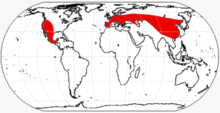Leptomerycinae
| Leptomerycinae Temporal range: Middle Eocene–Middle Miocene | |
|---|---|
| Scientific classification | |
| Kingdom: | Animalia |
| Phylum: | Chordata |
| Clade: | Synapsida |
| Class: | Mammalia |
| Order: | Artiodactyla |
| Family: | †Leptomerycidae |
| Subfamily: | †Leptomerycinae Zittel, 1893 |
| Genera | |
| |
 | |
| Range of Leptomerycinae based on fossil record | |
Leptomerycinae is an extinct subfamily within the ruminant family Leptomerycidae. It contains three genera, Leptomeryx, Pronodens, and Pseudoparablastomeryx, which lived in North America during the Middle Eocene to Middle Miocene. Leptomeryx may also have occurred in Asia during the Early Oligocene. The subfamily was first named by Zittel in 1893.[1]
Leptomerycinae were primitive and ancient ruminants, resembling small deer or musk deer, although they were more closely related to modern chevrotains. Its diet is stated to be that of a frugivore.
Taxonomy
Leptomerycinae was named by Zittel (1893). It was reranked as the subfamily Leptomerycinae by Matthew (1908). It was assigned to Hypertragulidae by Matthew (1908); and to Traguloidea by Carroll (1988).[2][3]
Morphology
Body mass
One specimen was examined by M. Mendoza, C. M. Janis, and P. Palmqvist for body mass:[4]
- 2.16 kg (4.8 lb)
References
- ↑ McKenna, M. C.; Bell, S. K. (1997). Classification of Mammals: Above the Species Level. Columbia University Press. p. 631. ISBN 978-0-231-11013-6.
- ↑ W. D. Matthew. 1908. Osteology of Blastomeryx and phylogeny of the American Cervidae. Bulletin of the American Museum of Natural History 24(27):535-562
- ↑ R. L. Carroll. 1988. Vertebrate Paleontology and Evolution. W. H. Freeman and Company, New York 1-698
- ↑ M. Mendoza, C. M. Janis, and P. Palmqvist. 2006. Estimating the body mass of extinct ungulates: a study on the use of multiple regression. Journal of Zoology 270(1):90-101